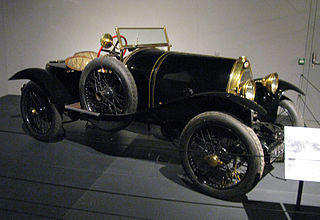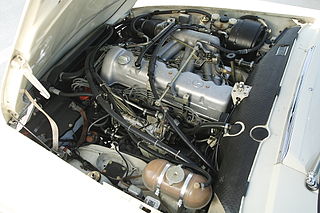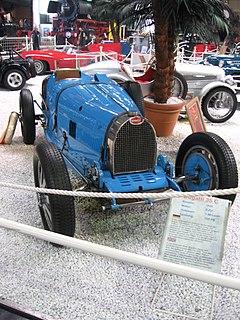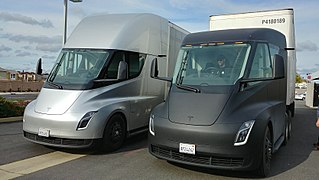
The straight-eight engine or inline-eight engine is an eight-cylinder internal combustion engine with all eight cylinders mounted in a straight line along the crankcase. The type has been produced in side-valve, IOE, overhead-valve, sleeve-valve, and overhead-cam configurations.

The Ferrari Colombo Engine was a petrol fueled, water cooled, carburetted 60° V12 engine designed by Gioacchino Colombo and produced in numerous iterations by Italian automaker Ferrari between 1947 and 1988.

The BMC B series was a line of straight-4 internal combustion engine mostly used in motor cars, created by British company Austin Motor Company.

The early Bugatti 8-cylinder line began with the 1922 Type 30. The same basic design was used for the 1926 Type 38 as well as the Type 40, Type 43, Type 44, and Type 49.

The Bugatti Type 57 and later variants was an entirely new design created by Jean Bugatti, son of founder Ettore. Type 57s were built from 1934 through 1940, with a total of 710 examples produced.

The Type 13 was the first true Bugatti car. Production of the Type 13 and later Types 15, 17, 22, and 23, began with the company's founding in 1910 and lasted through 1920 with 435 examples produced. Most road cars used an eight-valve engine, though five Type 13 racers had 16-valve heads, some of the first ever produced. The road cars became known as pur-sang ("thoroughbred") in keeping with Ettore Bugatti's feelings for his designs.

The Bugatti Type 18, also called the Garros, is an automobile produced from 1912 through 1914. Produced shortly after the start of the business, the design was something of a relic. It had much in common with the cars Ettore Bugatti had designed for Deutz Gasmotoren Fabrik but with the radiator of the Type 13. Only 6 or 7 examples were built.

The Bugatti Type 41, better known as the Royale, is a large luxury car built from 1927 to 1933 with a 4.3 m (169.3 in) wheelbase and 6.4 m (21 ft) overall length. It weighs approximately 3,175 kg (7,000 lb) and uses a 12.763 litre (778 cu in) straight-eight engine. For comparison, against the modern Rolls-Royce Phantom, the Royale is about 20% longer, and more than 25% heavier. This makes the Royale one of the largest cars in the world.

The Bugatti Type 46 and later Type 50 were large enclosed touring cars and along with the Type 50B racing version, were all produced in the 1930s. Their relative ubiquity and numbers, combined with their styling caused them to sometimes receive the appellation of being a Molsheim Buick.

The BMC E-series engine was a line of straight-4 and straight-6 overhead camshaft automobile petrol engines from the British Motor Corporation (BMC). It displaced 1.5 L or 1.8 L in four-cylinder form, and 2.2 L or 2.6 L as a six-cylinder. The company's native United Kingdom market did not use the 2.6 L version, which was used in vehicles of Australian and South African manufacture. Although designed when the parent company was BMC, by the time the engine was launched the company had become British Leyland (BL), and so the engine is commonly referred to as the British Leyland E-series engine.

The Bentley 3 Litre was a car chassis manufactured by Bentley. The company's first it was developed from 1919 and made available to customers' coachbuilders from 1921 to 1929. The Bentley was very much larger than the 1368 cc Bugattis that dominated racing at the time, but double the size of engine and strength compensated for the extra weight. The 4000 lb (1800 kg) car won the 24 Hours of Le Mans in 1924, with drivers John Duff and Frank Clement, and again in 1927, this time in Super Sports form, with drivers S. C. H. "Sammy" Davis and Dudley Benjafield. Its weight, size, and speed prompted Ettore Bugatti to call it "the fastest lorry in the world."

The MG F-type Magna is a six-cylinder-engined car that was produced by MG from October 1931 to 1932. It was also known as the 12/70.

Maserati A6 were a series of grand tourers, racing sports cars and single seaters made by Maserati of Italy between 1947 and 1956. They were named for Alfieri Maserati and for their straight-six engine.

The MG L-type is a sports car that was produced by the MG Car company in 1933 and 1934.

The MG N-type Magnette is a sports car that was produced by MG from October 1934 to 1936. The car was developed from the K-Type and L-Type but had a new chassis that broke away in design from the simple ladder type used on the earlier cars of the 1930s being wider at the rear than the front and with the body fitted to outriggers off the main frame.

The ALFA 40/60 HP is a road car and race car made by Italian car manufacturer ALFA. This model was made between 1913 and 1922 and was designed by Giuseppe Merosi, as were all other Alfas at that time. The 40/60 HP has a 6082 cc straight-4 engine with overhead valves, which produced 70 bhp (52 kW) and its top speed was 125 km/h (78 mph). The race model 40-60 HP Corsa had 73 bhp (54 kW) and a top speed of 137 km/h (85 mph), and it also won its own category in the Parma-Berceto race.

The Wolseley Hornet is a six-cylinder twelve fiscal horsepower lightweight automobile which was offered as a saloon car, coupé and open two-seater as well as the usual rolling chassis for bespoke coachwork. Produced by Wolseley Motors Limited from 1930 to 1936, the Hornet was unveiled to the public at the end of April 1930. Wolseley had been bought from the receivers by William Morris in 1927.

The Mercedes Benz M180 Engine was a 2.2 L; 134.0 cu in (2,196 cc) single overhead camshaft inline-6 cylinder engine introduced at the Frankfurt Motor Show in April 1951 to power the company's new 220 (W187). It was the first engine with a cylinder bore greater than its stroke that Mercedes had installed in a production car.

























